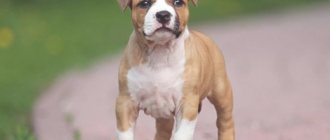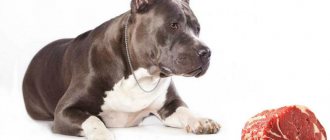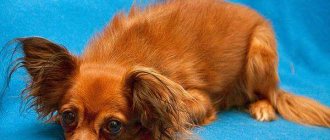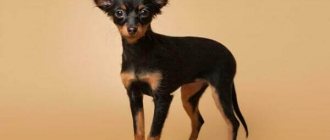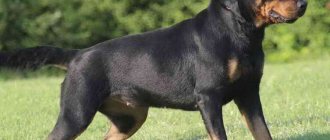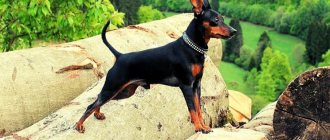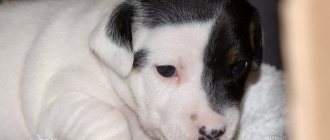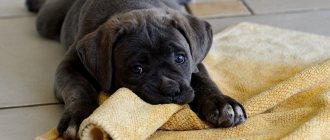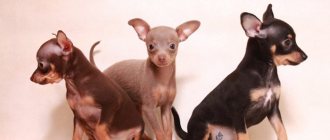The appearance of a pet in the house
If there is a small child in the family, you don’t have to worry, because the Amstaff’s behavior with children is distinguished by caution and understanding.
The dog knows very well that the child is much weaker and will succumb to the baby; it gets along well not only with children, but also with other pets.
Owners can recognize health problems by the following signs:
- Amstaff's nose is warm and completely dry, the pupils of the eyes are dull;
- poor sleep and loss of appetite;
- unpresentable appearance of dog hair, loss of shine;
- frequent urge to urinate, even breathing and wet mucous membranes.
American Staffordshire Terrier puppies need care and proper grooming. To prevent your dog from getting sick, you need to bathe it on time, walk it, and brush its teeth, ears and nose.
If you are thinking about buying a puppy of this breed, you need to know what types of terriers are available and what are their differences.
Training a pet up to 1.5 years old
A pet at this age is at the stage of socialization, he begins to understand who is his own and who is a stranger; divides the world into big and small; announces itself to the world around it.
At this stage, the foundation is laid for the correct attitude towards and understanding of human speech.
The four-legged pet should begin to contact other dogs of different ages, breeds and genders.
If you miss this moment, it will be difficult for the animal to find a common language with people, and it will be difficult to teach it any commands.
The dog will act nervously if there are other animals nearby.
Breed varieties
Show-class staff belong to high-breed dogs and have clearly defined qualities described in the breed standard.
This puppy is worth buying if you are serious about preparing for exhibitions, competitions, or want to open a kennel of American Staffordshire Terriers.
Breeding class - such dogs are also called breeding dogs, these are typical representatives of the Amstafa breed, which do not have strong deviations from the breed standard, and are suitable for exhibition and breeding.
Pet class. Such a pet may have defects. This could be an asymmetrical skull, dental irregularities, an unusual color for a Staffordshire Terrier, or an atypical tail shape.
Such defects do not have negative consequences for the health of puppies, but they are not suitable for breeding.
Feeding the baby from 2 months
up to 1.5 months – 6 times a day,
from 1.5 to 3 months – 5-4 times a day;
from 3 to 6 months – 3-4 times a day;
after 6 months – 2 times a day.
Considering that our puppies go to new families, having been raised on natural products, but are familiar and adapted to industrial food - dry and canned food, we hope that following the baby’s usual regime in the first weeks of the baby’s stay in the new home will help him quickly adapt to new family.
For the nutrition of puppies born and raised with us, we recommend the following products if the owner is ready to adhere to natural or mixed feeding.
- raw beef and beef by-products,
- lamb and lamb by-products,
-beef or lamb tripe, unpeeled, raw (can be used daily),
- chicken meat, as well as all chicken by-products - liver, heart, neck, gizzard (unpeeled, along with the yellow film must be given raw!),
-chicken or quail egg.
- natural cottage cheese (not to be confused with a cottage cheese product!). Fat content 5-9%.
Sometimes a puppy does not like cottage cheese, and it is perfectly replaced by Adygei, Suzdal, or analogues of young, unsalted cheese.
- kefir, or any fermented milk products 2.5% -4% fat,
- any sea fish without small bones (herring, capelin, hake, pollock, mackerel, pink salmon)
- seasonal vegetables and fruits, without exotic ones, in reasonable quantities.
-honey
Menu option for a puppy 2-3 months No. 1:
6.00-7.00: warm milk 1 tbsp. with raw chicken yolk, 1\2 tsp. honey, 2 tbsp. cottage cheese.
Important note - if you decide to stick to a mixed feeding option, it is in the morning feeding that it is better to offer the baby food in an amount that will correspond to one part of the daily diet recommended by the manufacturer.
10.00-11.00: raw beef cut into large pieces with veins and fascia (size about 1.5 matchboxes) (or chicken ventricles, 3-4 whole pieces, or chicken breast with breast cartilage, or unpeeled tripe in pieces) + coarsely cut raw cabbage, carrots or zucchini. For dessert, you can give a quarter of an apple.
15.00-16.00: Raw, unpeeled tripe (beef or lamb). For dessert, you can give a raw chicken wing (or 2 necks without skin), or a beef joint bone.
21.00-22.00: raw poultry liver, heart, chicken wing + 1/4 cup of kefir or fermented baked milk (this can be left overnight if the baby does not finish it).
We recommend adding vitamin supplements to the diet of our babies up to 1-1.5 years: 1) from the Canina series, or more budget 8 in 1, over time other vitamin complexes appear, and the breeder will recommend the one he would prefer specifically for your puppy .
We can also use:
2) veterinary fish oil,
3)dried kelp thallus.
Menu option for a puppy 2-3 months No. 2
6-7 am: dry food (1/4 of the daily feeding norm)
10-11 hours: raw chicken neck (about 4 pieces), or wings (2 pieces), or back - raw, then for dessert a leaf of cabbage or head lettuce, ¼ apple
15-16 hours: 100 grams of cottage cheese, 2-3 times a week - raw egg yolk to it, 1/4 teaspoon of honey.
After this feeding, which is fairly light, about an hour later, you can work with the puppy in any type of training and offer dried or dried lung or liver as a reward.
21-22 hours: at night, a denser meal - unpeeled beef tripe, about 250 grams, cut into large pieces, so that the puppy not only swallows his portion, but works with all his teeth, gnawing and chewing his dinner thoroughly. For dessert, you can give fermented baked milk or kefir in small quantities.
Menu option for a 4 month old puppy.
7:30 Dry food, ¼ of the daily value. Ryazhenka or yogurt 100 ml. A piece of apple.
12:30 raw meat or chicken) 200 g. some may be in the form of by-products. Vegetables (beets, carrots, potatoes, various cabbage, leeks in the form of a salad or vinaigrette with vegetable oil with the addition of fresh lettuce, spinach, herbs). Vitamins (as recommended by the manufacturer).
17:00 Cottage cheese 2% 200 g. Kefir 100 ml. Mineral supplement (as recommended by the manufacturer). Chicken neck or wing.
21:30 Raw meat in large pieces with cartilage or tripe 200 g. Head lettuce leaf. After about an hour and a half, natural yogurt (one jar). Raw carrots, apple slices, pears as “nibbles” during the day.
Please do not forget that all the examples described above are approximate, and it is necessary to take into account the baby’s fatness, his activity, and even the time of year and weather changes - often the baby reacts to cold weather or rain with an increased appetite, and in the heat, on the contrary, eats worse.
Menu option for a 5-6 month old puppy:
8.00 Dry food, natural yoghurt
14.00 Protein food food 250 gr. (fish, chicken, offal, cottage cheese), vegetable salad or vegetables in 50 g pieces, vitamins, mineral supplements.
20.00 Raw meat with cartilage 300-350 gr. (beef, veal), fresh vegetables or fruits (whole carrots, apple, pear). For dessert, yogurt 100 gr.
An egg is added 2 times a week.
Fruits can be given freely throughout the day, for example, for completing some commands. Usually these are seasonal and those that are typical for the region where the puppy lives, in small quantities. The main condition: the puppy must tolerate well the type of fruits and vegetables that the owner adds to the diet.
In the example below is a list of vegetables and fruits from the diet of some of our graduates.
These can be: pears, apples, berries (blackberries, raspberries, strawberries, pitted cherries), pumpkin, zucchini, celery, tomatoes, cucumbers, spinach, chard, lettuce, white cabbage, cauliflower, Brussels sprouts, broccoli.
Owners must remember that the main waste product of a dog is meat. Therefore, vegetable and fruit supplements should not occupy a leading place in a dog’s diet.
The character of doggies and their upbringing
The Amstaff puppy looks like a chubby round puppy with a bare belly.
He is very active, enjoys chewing on slippers and loves to misbehave in the house in every possible way.
For this reason, from the first days of acquaintance, you need to educate him and accustom him to order.
To prevent your dog from dragging your socks, T-shirts and other items around the room, make sure you have a sufficient arsenal of toys. They should be made of a variety of materials.
There are whole myths and legends about the aggressive character traits of Staffordshire Terriers. It depends only on the owners how this pet will grow up.
If you abandon your dog and do not pay enough attention to its upbringing, the older dog may become angry and show aggression.
To achieve obedience and correct behavior from a four-legged animal, follow some rules.
Namely:
The educational process should begin at the age of no later than 1.5-6 months. Even as a baby, a terrier must understand what behavior is acceptable and what is not.
Then you won’t have any difficulties when the dog grows up and his character develops.
Introduce your four-legged friend to the environment from the very first days, always praise for correctly executed commands and punish for misbehavior and incorrect behavior.
But you cannot punish a dog by shouting or using physical force.
Provide your pet with a well-chosen and balanced menu. You can consult your veterinarian on this issue.
The diet must contain water, dietary supplements, minerals and vitamins of groups A, B, C, D, E, K.
Staffordshire Bull Terrier puppies are smaller than American Staffordshire Terriers, but both breeds have bold personality traits.
Such dogs are good protectors and loyal friends for the whole family. With the right approach to education, a terrier is distinguished by its intellectual abilities and the ability to restrain emotions even under the most unexpected circumstances.
Care and maintenance
Teeth
Many owners, due to their inexperience, begin to play the game “tug of war” with terrier puppies.
This game is very useful and interesting for pets, but at the age of up to 4 months, it can be dangerous for the baby.
The essence of the game is to take away a rope or piece of fabric from each other. For this activity, buy a rope at a specialty store.
Why might this be dangerous for the puppy? She may develop an incorrect bite, and when all the teeth are fully formed, she can play with a rope or string without fear.
When all the teeth are replaced with new ones, they need care. The dog is not able to provide the necessary care for its oral cavity on its own.
You will need dog toothpaste, which should be periodically applied to your puppy's teeth with your fingers or a brush.
Never use human toothpaste, it is very foamy and causes stomach upset in animals.
Feeding
Staffordshire Terrier puppies must get used to a certain diet during childhood.
In the first months of life, they are fed up to 5-6 times a day, but in small portions so that the baby does not overeat.
If you find leftover food after eating, hide it until next time. Don't let your dog eat at random.
Your pet should have only water freely available at all times, because he spends a lot of energy reserves and strength on games and pampering.
As they grow older, the number of meals is reduced, but the volumes increase. Upon reaching 4 months, the dog eats three meals a day, and an adult dog needs two meals.
Treatment
Your home must have a first aid kit containing everything your pet needs in case emergency assistance is needed.
Puppies are like children and strive to climb absolutely everywhere, they can chew through wires, dump something heavy on themselves, and so on.
The first aid kit should contain iodine, bandages, medications for treating the animal after injury, painkillers and other medications.
Your veterinarian can advise you on a more extensive list that you should stock up on.
Buying and selling
Where is it generally customary to buy and sell these animals? First of all, we need to talk about nurseries.
By choosing an American Staffordshire Terrier kennel, you can find a healthy and beautiful dog of this breed.
But be prepared for the corresponding prices; check immediately how much a puppy costs in a particular nursery.
In such places, the best puppies of the litter are often kept, and the rest are offered for sale, and at an exorbitant price.
On the Internet you can find out how much such a puppy costs from private sellers. In this case, you need to try to protect yourself by asking the sellers to show not only the staff, but also his parents.
This method is good because it will be convenient to pick up the puppy in your city. But despite the prices, nurseries are safer places for such purchases.
If you decide to become a Stafford breeder yourself, know that it is troublesome, but can bring good income.
These puppies have always been appreciated, how much does a staff cost?
The price varies between 50-1000 dollars, depending on the pedigree, documents and place of purchase.
Once you get such a dog, you won’t want another one; the Stafford is a wonderful companion, a guard and just a funny dog!
Features of raising puppies in the first year of life
An Amstaff puppy under the age of one year does not need to be trained, but raised. And if you treat this with a certain degree of negligence, it can grow into a dangerous, aggressive creature, despite the genetically inherent love for a person. To raise a responsive, friendly dog, you should not ignore the slightest hint of aggression, even in a tiny puppy. Otherwise, it is unlikely that in the further process of education a Staffordshire Terrier will grow up to be socially safe for surrounding people and animals.
Do you train your Amstaff?
Yes
39.07%
So far only in plans
60.93%
It is important to clearly understand that in the first year of life a Staffordshire cat needs education, patience and love. There will still be time for training, but if you miss the age at which you need to explain to the Amstaff how to behave in the house, on the street, in communication with people and other animals, problems will be guaranteed. Such a dog can only be walked with on a leash, away from society, and this will interfere with its harmonious psychological, intellectual and physical development.
At about the age of 7-8 months, Staffordshires have a clearly visible temperament. Amstaffs come in two character types: aggressive people who like to fight and sweet, good-natured people who do not tolerate squabbles. The entire training system should be based on this. It all depends on what goal the owner sets for himself, and who he wants to get in the end: a fighter or a defender.
Training a Staffordshire Terrier is a process whose goal is to develop certain skills and abilities that can be used to control the behavior of the animal.
In addition, training a Stafford has its own characteristics, so it is better to start training when the puppy reaches the age of 4 months. During this period, the puppy has the necessary physical data to carry out commands.
Training should be based on such types of exercises, the purpose of which is to achieve and polish the necessary reflexes in the dog. Therefore, the animal owner needs to clearly understand what he wants from his pet in order to structure training in the right way. Training at home is basic and the knowledge gained from the owner of the house will serve as an excellent foundation for special training.
As soon as the dog reaches the age of 7 months, it can be trained in special dog training areas. Contrary to public opinion, Staffordshire Terriers are very intelligent and perfectly understand and perform the assigned task, therefore, if you approach training wisely and responsibly, difficulties should not arise.
Photo gallery
Despite the widespread opinion about the aggressiveness of this breed, it should be said that with proper care and education, your pet will pleasantly surprise others with its friendliness and calmness.
In this video you will see how a three-month-old American Staffordshire Terrier puppy is taught to behave correctly on the street.
Dry food for puppies
What to feed a Pembroke Corgi for an adult and a puppy
At six months the puppy can be switched to dry food. The transition from homemade food to dry food is made gradually, first by giving the pet canned food. They are fed pure or mixed with natural products. When choosing dry food, you should give preference to the premium class. What to look for before feeding your Stafford puppy:
- the food is intended for puppies;
- appropriate for the age and weight of the baby.
For your information! Dry food is a ready-made balanced diet, so there is no need to give vitamin and mineral complexes.
The food needs to be replaced if the Staffordshire Terrier refuses it. It is important to remember about clean water, which should always be near the bowl of food.
Caring for an American Staffordshire Terrier puppy
Finally, the puppy is chosen, and you, overwhelmed with joy, rush home.
If you purchased a puppy at the age of 1.5-2 months, then the main thing you should worry about is quarantine. An unvaccinated puppy is vulnerable to various diseases, so you should never take him for a walk, and at home you need to make sure he doesn’t pee on your outdoor shoes. It is better if the puppy has limited access to the part of the corridor where you take off your shoes. The first vaccination is given at 2 months, the second - at the discretion of the veterinarian, who must be licensed, is given after 2-3 weeks.
The dates of vaccination are recorded by the doctor in the veterinary passport. If you purchased a puppy that has already grown up (4-6 months), then you should be given a veterinary passport along with the main documents for the dog. Health issues, which include deworming and vaccination, as well as the quarantine accompanying these measures, are perhaps the most important, and they must be treated with full responsibility.
To have your puppy's ears cropped, you need to invite a veterinarian who has extensive experience working with Staffordshire dogs .
The procedure for ear cropping is simple and, from a technical point of view, any surgeon can handle it, but only an experienced veterinarian can choose the appropriate ear shape for a particular dog, taking into account the type and shape of the head. The breed standard, as you know, gives preference to undocked ears, but still, from an aesthetic point of view, a Stafford's head with beautifully cropped ears looks great. For a happy life, your puppy needs a certain set of tools and accessories. First of all, it's a "place". A plastic bed, which can be bought at any pet store, is perfect for these purposes. You need to select it taking into account the size of an adult dog, the bed is very easy to wash, dogs like it because of the “nest” effect. If you put thick bedding inside, the puppy will feel cozy and protected.
How to choose a diet for a Staffordshire Terrier
Meat should be the main product and make up half or most of the diet. Beef, veal, and horse meat are suitable for this. Poultry and rabbit meat are given carefully. Raw meat is preferable to cooked meat; it contains more nutrients, but requires pre-treatment with boiling water to kill parasites. By-products must be pre-cooked, except tripe. They differ in calorie content and can lead to unwanted weight gain. It is not advisable to give them daily. The diet can be varied with sea fish, from which the bones are first removed.
The diet includes chopped and whole vegetables - carrots, zucchini, pumpkin, beets, cucumbers. An adult dog can be given raw chicken and quail eggs. Fruits and berries such as bananas, apples, strawberries, blueberries are added to dairy products.
Important! When feeding natural products, the dog will need vitamin and mineral complexes.
